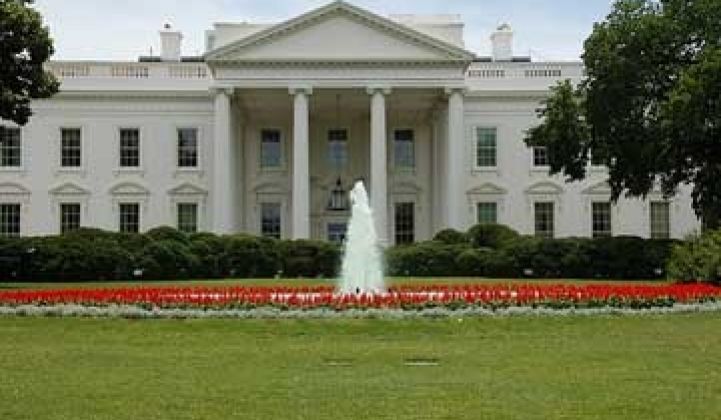It was just last year that eMeter jumped into the crowded room of home energy management, and now it's taking its case to the White House. The Obama family will not be receiving the company's Energy Engage platform, but instead, eMeter Chief Regulatory Officer Chris King will brief members of the Executive Office of the President, the Department of Energy, and the National Science and Technology Council on the results of the PowerCents DC Program.
The program piloted meters and thermostats alongside time-of-use pricing and eMeter's Energy Engage system with about 900 Pepco customers in the District of Columbia from mid-2008 to late 2009.
The company is best known for its software that helps utilities analyze the data from consumers' homes, transformers, and other pieces of equipment. IBM has begun to pre-bundle the software on servers and will help eMeter promote its software even more in the market. But this is kind of like the coming-out party for eMeter's residential energy management system. The product isn't fancy, but it also isn't getting anyone angry.
"I'm excited about being able to communicate that there are a lot of happy customers," said King. "The headlines tend to pick up [angry PG&E customers in] Bakersfield, but there are a lot of rollouts where customers are happy and excited to get this technology."
For the PowerCents Program, customers were split into three groups. The first were enrolled in hourly pricing, where peak rates were higher for a few hours a day and lower the rest of the time; the next group received critical peak pricing where they paid much more during critical peak hours for about 15 days a year but paid less during the rest of the year, while the final group received rebates for reducing energy consumption during critical peak hours.
Along with TOU pricing, participants received monthly energy reports and in-home displays with real time pricing and online access to Energy Engage, which showed detailed energy consumption data and tips for conservation.
Over the course of the pilot, 90 percent of customers saved money -- an average of $44 per year -- and more than 90 percent said they would recommend the program to friends and family. "What's important to people is, 'what can I do to change my bill?'" said King. "You do have people who literally saved hundreds of dollars in the pilot."
While the cost savings might not seem like much to some, the peak reduction during summer was impressive, up to 50 percent. The greatest reductions came when critical peak pricing was in place along with automated central air conditioner control via smart thermostats. The thermostats could be set so that when critical peak demand hit, energy usage would automatically be lowered.
The pilot also included a significant number of low-income customers. Low-income homes comprised 15 percent of the pilot, although they only account for about half that figure in the area's demographics. This is one of the most interesting findings, as home management companies and utilities figure out how to engage low-income customers in software that is often geared towards the tech-savvy crowd with a home broadband connection.
There was no real-time pricing, but King argued that it's not ultimately that important for people. "If I turn the light off, I know I'm going to save energy," he said. "Time-of-use will give them more options." But King also acknowledged that TOU pricing has to be voluntary to work, or at least not cost customers money, like with a rebate program for people who reduce energy use during critical peak periods.
Other companies like OPower also have a similar approach to filling the gap to engage the low-income and low-tech residential market, including engaging customers using everything from smart phones to good old-fashioned snail mail. Over all, Energy Engage is not necessarily offering a product that is so different from others on the market. While some companies like Powerhouse Dynamics don't see the utility as the way to engage customers, eMeter is already servicing utilities and has optimized its product to be built into the utility's website. "We're not about getting between the utility and their customer," said King.
Other companies may already have their home energy management systems in many more homes, but eMeter has an advantage because the energy management platform is a complement to its core business of meter data management, where it already has a strong toehold with at least 20 million meters under contract.
Now that the pilot is over, eMeter is hoping to be a part of Pepco's entire smart meter rollout, although the DC Public Service Commission has not made a decision on pricing or home energy management systems that might be a part of that installation.



